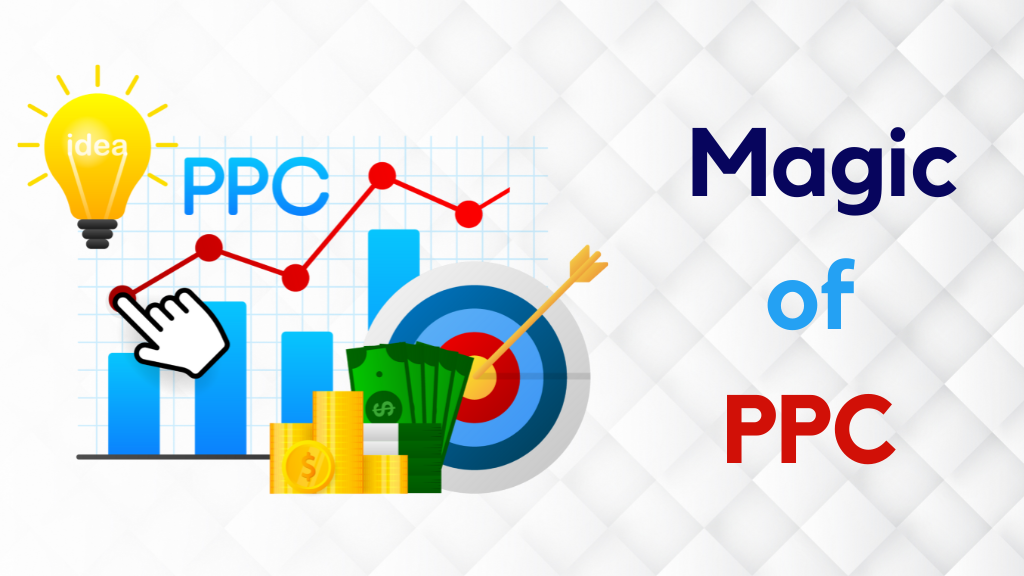- March 15, 2023
- Tejhaksh
- 0 Comments
- Marketing, Digital Marketing, Social media Marketing
Mastering PPC Advertising: A Beginner’s Guide to Driving Targeted Traffic and Boosting Conversions

What is PPC Advertising, Pay Per Click?

PPC advertising, or pay-per-click advertising, is a form of online advertising where advertisers pay a fee each time their ad is clicked. It is a popular form of digital marketing used by businesses of all sizes to drive traffic, leads, and sales to their websites.
PPC advertising works by allowing businesses to bid on specific keywords or phrases that are relevant to their products or services. When a user enters a search query that matches the advertiser’s chosen keywords, the ad is triggered and displayed at the top or bottom of the search engine results page (SERP), marked as a “sponsored” or “ad” listing.
Advertisers only pay when a user clicks on their ad, hence the name “pay-per-click.” The cost per click (CPC) varies depending on the competition for the chosen keywords, the ad and landing page quality, and the maximum bid set by the advertiser. The higher the bid, the higher the chance of the ad being displayed in a top position.
PPC advertising is not limited to search engines but can also be used on social media platforms, display networks, and video channels. In social media PPC, businesses can target specific demographics, interests, and behaviors of users to display their ads in their news feeds or stories. In display network PPC, businesses can place their ads on websites that are part of the ad network, such as Google AdSense, using targeting options such as topic, placement, and audience. In video PPC, businesses can display their ads on YouTube or other video channels, using targeting options such as keywords, demographics, and interests.
PPC advertising offers several benefits to businesses, including:
- Instant visibility and results: PPC ads can be created and launched quickly, providing businesses with instant visibility and results.
- Targeted and measurable: PPC advertising allows businesses to target specific keywords, demographics, interests, and behaviors of users, making it highly targeted and measurable.
- Cost-effective: PPC advertising allows businesses to control their budget, set maximum bids, and only pay when a user clicks on their ad, making it cost-effective.
- Flexibility and control: PPC advertising allows businesses to adjust their bids, ad copy, landing pages, and targeting options based on real-time data and results, giving them flexibility and control over their campaigns.
- Brand awareness and reach: PPC advertising allows businesses to reach a wider audience, increase brand awareness, and drive traffic and sales to their website.
However, to get the most out of PPC advertising, businesses need to create compelling ad copy, and relevant landing pages, and choose the right keywords and targeting options. They also need to monitor and optimize their campaigns regularly, measure their results, and adjust their strategies based on the data and insights gained.
In summary, PPC advertising is a powerful digital marketing tool that can help businesses drive traffic, leads, and sales to their website. By understanding how PPC advertising works, businesses can create effective campaigns that reach their target audience and achieve their marketing goals.
How it’s making everything easier?

PPC advertising has revolutionized the way businesses approach digital marketing. It has made marketing easier and a lot more result-oriented in several ways:
- Highly targeted: PPC advertising allows businesses to target specific keywords, demographics, interests, and behaviors of users, making it highly targeted. This means that businesses can reach their ideal customers at the right time with the right message, increasing the chances of converting them into leads or sales.
- Measurable: PPC advertising provides businesses with measurable results, allowing them to track their campaign performance, measure their return on investment (ROI), and adjust their strategies based on the data and insights gained. This means that businesses can make informed decisions about their marketing budget, targeting options, ad copy, and landing pages, maximizing their results.
- Cost-effective: PPC advertising allows businesses to control their budget, set maximum bids, and only pay when a user clicks on their ad, making it cost-effective. This means that businesses can reach their target audience without breaking the bank and achieve a positive ROI.
- Faster results: PPC advertising provides businesses with instant visibility and results. Unlike organic search engine optimization (SEO), which can take months to show results, PPC advertising can generate leads and sales within hours or days of launching a campaign.
- Flexibility and control: PPC advertising allows businesses to adjust their bids, ad copy, landing pages, and targeting options based on real-time data and results, giving them flexibility and control over their campaigns. This means that businesses can optimize their campaigns for maximum results and adjust their strategies based on changing market conditions or business objectives.
- Brand awareness and reach: PPC advertising allows businesses to reach a wider audience, increase brand awareness, and drive traffic and sales to their website. This means that businesses can attract new customers, expand their market share, and stay ahead of the competition.
In conclusion, PPC advertising has made marketing easier and a lot more result-oriented by providing businesses with highly targeted, measurable, cost-effective, fast, flexible, and controllable campaigns. By leveraging the power of PPC advertising, businesses can achieve their marketing goals, grow their customer base, and increase their revenue and profits.
Where to start the journey?

When starting with PPC advertising, there are several steps businesses can take to get some traffic and increase their chances of success. Here are some tips:
- Define your marketing goals: Before launching a PPC campaign, businesses need to define their marketing goals, such as increasing website traffic, generating leads, or boosting sales. This will help them choose the right keywords, targeting options, ad copy, and landing pages that align with their objectives.
- Choose the right keywords: Keywords are the foundation of PPC advertising. Businesses need to choose relevant, high-traffic keywords that match the search queries of their target audience. They can use keyword research tools, such as Google Keyword Planner, to find the best keywords for their campaigns.
- Write compelling ad copy: Ad copy is what entices users to click on the ad and visit the website. Businesses need to write compelling, attention-grabbing ad copy that highlights the unique selling proposition of their products or services. They can use ad copywriting best practices, such as using action-oriented language and including a clear call-to-action (CTA).
- Create targeted landing pages: Landing pages are where users are directed after clicking on the ad. Businesses need to create targeted landing pages that align with the ad copy and provide a seamless user experience. The landing page should be visually appealing, easy to navigate, and contain a clear CTA.
- Set a realistic budget: PPC advertising can be costly if not managed properly. Businesses need to set a realistic budget based on their marketing goals, industry competition, and available resources. They can start with a small budget and gradually increase it as they see positive results.
- Monitor and optimize campaigns: PPC advertising requires ongoing monitoring and optimization to achieve maximum results. Businesses need to track their campaign performance, measure their ROI, and adjust their strategies based on the data and insights gained. They can use PPC management tools, such as Google Ads, to monitor and optimize their campaigns.
In summary, to get some traffic on their business in PPC, businesses need to define their marketing goals, choose the right keywords, write compelling ad copy, create targeted landing pages, set a realistic budget, and monitor and optimize their campaigns. By following these tips, businesses can attract targeted traffic, generate leads, and increase their revenue and profits.
What not to do?

PPC advertising can be an effective way to drive traffic and generate leads for businesses, but there are also some common mistakes that can lead to wasted resources and poor results. Here are some things to avoid when dealing with PPC:
- Not defining clear marketing goals: Without clear marketing goals, businesses may waste resources targeting the wrong audience, using irrelevant keywords, or driving traffic to ineffective landing pages. It’s important to set specific, measurable, and realistic goals that align with the business’s objectives.
- Targeting the wrong audience: Targeting the wrong audience can result in low-quality traffic, low click-through rates, and wasted ad spending. It’s important to use the targeting options available in the PPC platform, such as location, demographics, and interests, to reach the right audience.
- Using irrelevant or low-quality keywords: Using irrelevant or low-quality keywords can lead to low click-through rates, high bounce rates, and wasted ad spending. It’s important to conduct thorough keyword research and choose relevant, high-traffic keywords that match the search intent of the target audience.
- Writing poor ad copy: Poor ad copy can result in low click-through rates and wasted ad spending. It’s important to write compelling, attention-grabbing ad copy that highlights the unique selling proposition of the business and includes a clear call to action.
- Neglecting landing page optimization: Neglecting landing page optimization can lead to high bounce rates, low conversion rates, and wasted ad spend. It’s important to create targeted landing pages that align with the ad copy and provide a seamless user experience.
- Not monitoring and optimizing campaigns: Not monitoring and optimizing campaigns can result in poor performance and wasted ad spending. It’s important to track the campaign performance, measure the ROI, and adjust the targeting options, ad copy, and landing pages based on the data and insights gained.
In summary, to avoid common pitfalls when dealing with PPC advertising, businesses should define clear marketing goals, target the right audience, use relevant and high-quality keywords, write compelling ad copy, optimize landing pages, and monitor and optimize campaigns. By avoiding these mistakes, businesses can achieve maximum results and make the most of their PPC advertising investment.
Magic of PPC

Pay-per-click (PPC) advertising has become a magical tool for many businesses looking to boost their online visibility, attract targeted traffic, and generate leads. Here are some ways PPC has made it magical for many businesses:
- Highly targeted audience: PPC advertising allows businesses to target their ads to specific audiences based on demographics, interests, behaviors, and search queries. This means that businesses can reach the right people at the right time, increasing their chances of conversion.
- Immediate results: Unlike traditional marketing methods, which can take weeks or months to see results, PPC advertising can deliver immediate results. Businesses can launch a PPC campaign and start seeing traffic and leads within hours or days.
- Cost-effective: PPC advertising is cost-effective because businesses only pay when someone clicks on their ad. This means that they can control their ad spend and allocate their budget to the most effective campaigns and keywords.
- Measurable ROI: PPC advertising provides businesses with measurable ROI because they can track their campaign performance and analyze the data and insights gained. This means that they can adjust their strategies based on the data and optimize their campaigns for maximum results.
- Flexibility: PPC advertising is highly flexible because businesses can adjust their campaigns in real time based on performance data and market trends. They can test different ad copy, landing pages, and targeting options to find the most effective combination.
- Brand awareness: Even if a PPC ad doesn’t result in an immediate conversion, it can still increase brand awareness and recognition. This means that businesses can reach potential customers who may not have been aware of their brand before.
In summary, PPC advertising has made it magical for many businesses by providing them with a highly targeted audience, immediate results, cost-effectiveness, measurable ROI, flexibility, and brand awareness. By leveraging the power of PPC, businesses can achieve their marketing goals, grow their customer base, and increase their revenue and profits.


Leave a Comment